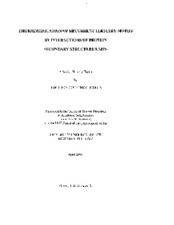| dc.creator | Hodges, Hamilton Courtney | |
| dc.date.accessioned | 2013-02-22T20:41:27Z | |
| dc.date.available | 2013-02-22T20:41:27Z | |
| dc.date.created | 2003 | |
| dc.date.issued | 2013-02-22 | |
| dc.identifier.uri | https://hdl.handle.net/1969.1/ETD-TAMU-2003-Fellows-Thesis-H62 | |
| dc.description | Due to the character of the original source materials and the nature of batch digitization, quality control issues may be present in this document. Please report any quality issues you encounter to digital@library.tamu.edu, referencing the URI of the item. | en |
| dc.description | Includes bibliographical references (leaves 47-51). | en |
| dc.description.abstract | Proteins are the molecular machines that drive the processes of the cell; they carry out the functional and structural instructions outlined in an organism's genome. At their simplest, these biological catalysts are comprised of linear chains of amino acids that fold into unique three-dimensional structures. One of the goals of structural biology is to predict a protein's three-dimensional structure from its amino acid sequence. One important aspect of protein structure is the manner by which the non-covalent or weak interactions bring about a protein's fold. Often called tertiary interactions, these noncovalent interactions are often between amino acid residues that are distant in the linear sequence but close in three-dimensional space. Through an informatics analysis of recurrent tertiary contacts, we have derived a database of recurrent tertiary motifs. A group of 691 high-resolution, non-redundant protein structures was obtained. For each protein in this source data, we found all secondary structure units: alpha helices, beta strands, beta hairpins, and loops. We also identified three physical interactions between the secondary structure units: (1) hydrogen bonds were found by a continuous energy potential; (2) salt bridges were determined by a distance cutoff between oppositely charged atoms; and (3) hydrophobic contacts were derived from Voronoi polyhedra around carbon atoms. From the interactions between secondary structures, we identified the 21,100 protein substructures defined by tertiary interactions. These pieces of proteins were then clustered based on structural similarity into 4,039 groups. Each group represents a tertiary motif. Such a high number of recurrent contact pairs from a non-redundant sample source suggests that there is at least some level of redundancy for these non-covalent tertiary interactions. Applications for this tertiary motif database are currently being developed, with special interest in tertiary structure prediction. | en |
| dc.format.medium | electronic | en |
| dc.format.mimetype | application/pdf | |
| dc.language.iso | en_US | |
| dc.publisher | Texas A&M University | |
| dc.rights | This thesis was part of a retrospective digitization project authorized by the Texas A&M University Libraries in 2008. Copyright remains vested with the author(s). It is the user's responsibility to secure permission from the copyright holder(s) for re-use of the work beyond the provision of Fair Use. | en |
| dc.subject | biochemistry. | en |
| dc.subject | Major biochemistry. | en |
| dc.title | The identification of recurrent tertiary motifs by interactions of protein secondary structure units | en |
| thesis.degree.department | biochemistry | en |
| thesis.degree.discipline | biochemistry | en |
| thesis.degree.name | Fellows Thesis | en |
| thesis.degree.level | Undergraduate | en |
| dc.type.genre | thesis | en |
| dc.type.material | text | en |
| dc.format.digitalOrigin | reformatted digital | en |


